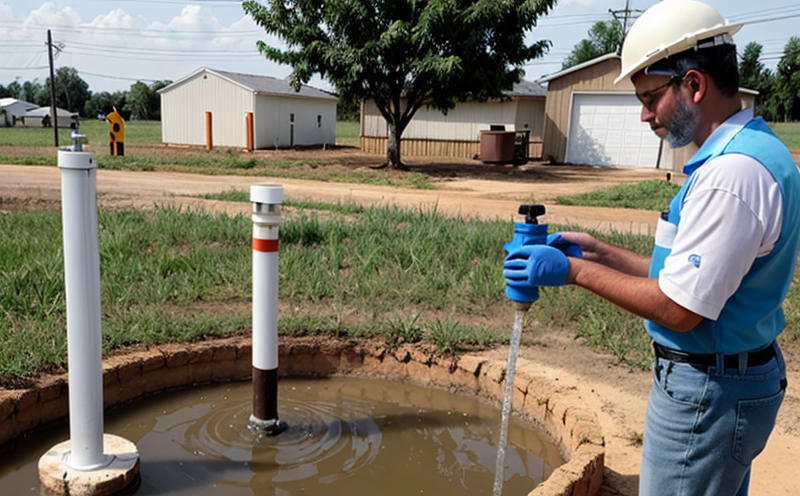ISO 9174 Chromium Testing in Groundwater
The ISO 9174 standard provides a robust framework for the determination of chromium (Cr) in groundwater. Chromium is an essential trace element that plays critical roles in metabolism, but its presence in excess can pose significant environmental and health risks. Compliance with this standard ensures accurate detection and quantification of hexavalent chromium (Cr(VI)), which is highly toxic, and trivalent chromium (Cr(III)), which is less harmful.
The importance of ISO 9174 Chromium Testing cannot be overstated in the water & wastewater testing sector. Hexavalent chromium has been linked to various adverse health effects including cancer, respiratory issues, and neurological damage. Therefore, accurate monitoring and reporting are crucial for regulatory compliance and public safety. This service supports a wide range of stakeholders such as quality managers, compliance officers, R&D engineers, and procurement teams.
The testing process involves several steps: sampling, sample preparation, digestion, and analysis using various instrumental techniques like inductively coupled plasma mass spectrometry (ICP-MS) or colorimetric methods. The choice of technique depends on the specific requirements for sensitivity, precision, and matrix complexity.
Sample preparation is a critical step that involves filtering, diluting, and digesting samples to ensure they are compatible with the analytical method used. Digestion typically utilizes strong acids like nitric acid or perchloric acid at high temperatures to break down organic matter and liberate chromium ions into solution form.
| Sample Preparation Steps | Description |
|---|---|
| Filtering | To remove particulates that may interfere with the analysis. |
| Dilution | To ensure the sample concentration is within the detection limits of the analytical method. |
| Digestion | To convert all chromium compounds into soluble forms for accurate quantification. |
The quality and reliability of the test results are paramount. The ISO 9174 standard ensures that these tests yield accurate, repeatable, and reliable data. Compliance with this standard is essential to ensure that regulatory requirements are met and public health is protected.
- Sampling must follow strict protocols to avoid contamination and ensure representativeness.
- The choice of analytical method should consider the matrix complexity and desired sensitivity.
- Digestion conditions need to be optimized for complete sample conversion without introducing artifacts.
Our laboratory adheres strictly to ISO 9174 guidelines, ensuring that our clients receive accurate and reliable results. This service is vital in sectors where water quality is a critical concern, such as municipal water supply, industrial processes, and environmental monitoring.
The demand for this testing has grown significantly due to increasing awareness of the risks associated with hexavalent chromium contamination. Regulatory bodies worldwide are implementing stricter standards to protect public health and the environment. Our service not only meets these regulatory requirements but also provides actionable insights that can inform corrective actions and improvement strategies.
Scope and Methodology
The ISO 9174 standard covers the determination of chromium (Cr) in groundwater by various analytical methods, including atomic absorption spectrophotometry (AAS), inductively coupled plasma optical emission spectroscopy (ICP-OES), and inductively coupled plasma mass spectrometry (ICP-MS). The method of choice depends on factors such as the matrix complexity, desired sensitivity, and precision.
| Method | Description |
|---|---|
| AAS | Involves flame or graphite furnace atomization followed by measurement of light absorption at specific wavelengths. Suitable for routine analysis with moderate precision. |
| ICP-OES | Uses inductively coupled plasma to ionize sample elements, followed by detection using optical emission spectroscopy. Offers high sensitivity and wide dynamic range. |
| ICP-MS | Involves ionizing the sample in an inductively coupled plasma, then detecting ions through mass spectrometry for high precision and low limits of detection.
The methodology outlined in ISO 9174 ensures that the samples are prepared correctly, analyzed accurately, and reported precisely. The standard specifies detailed procedures for sample handling, digestion, calibration, and quality control measures to ensure reproducibility and reliability of results.
Calibration is a crucial aspect of this testing procedure. Calibration solutions should be standardized against certified reference materials (CRMs) traceable to international standards like ISO or ASTM. This ensures that the instrument response is linear and accurate over the entire measurement range.
Quality and Reliability Assurance
- Calibration: Regular calibration of instruments using certified reference materials (CRMs) to ensure accuracy and precision.
- Digestion Conditions: Optimal digestion conditions are crucial for complete sample conversion without introducing artifacts. This includes selecting appropriate acids, concentrations, and temperatures.
- Sample Handling: Careful handling of samples from collection to analysis to prevent contamination and ensure representativeness.
- Data Validation: Use statistical methods to validate data quality, ensuring that the results meet predefined acceptance criteria.
The use of certified reference materials (CRMs) in calibration is essential for validating instrument performance. These CRMs are traceable to international standards like ISO or ASTM, providing a consistent basis for comparison. Regular inter-laboratory comparisons further enhance data reliability by confirming that results across different laboratories are comparable.
Data validation using statistical methods ensures that the reported results meet predefined acceptance criteria. This includes assessing precision and accuracy through replicate analysis of spiked samples and standard reference materials (SRMs). The use of SRMs allows for direct comparison with certified values, providing confidence in the analytical process.
Competitive Advantage and Market Impact
Our ISO 9174 Chromium Testing service offers significant competitive advantages in the water & wastewater testing sector. By adhering strictly to international standards, we ensure that our clients receive accurate, reliable, and actionable results. This not only supports regulatory compliance but also informs strategic decision-making processes.
The demand for this testing has grown significantly due to increasing awareness of the risks associated with hexavalent chromium contamination. Regulatory bodies worldwide are implementing stricter standards to protect public health and the environment. Our service is designed to meet these evolving requirements, providing clients with a competitive edge in meeting regulatory expectations.
Our testing methodologies are continuously updated to align with the latest scientific advancements and international standards. This ensures that our clients receive the most accurate and up-to-date results possible. By leveraging this expertise, we contribute to safer water supplies and more sustainable environmental practices.





